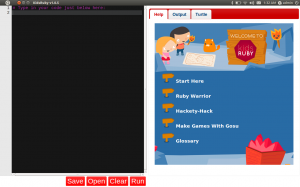I have two kids, and I have been wanting to find ways to introduce my kids to programming. Especially for my son, who has asperger syndrome. I thought programming would be a good way to use his interests in logic and mathematics to good use.
I was so much in joy when I found KidsRuby. It’s an awesome project. I think Ruby is a great first language because of its elegance and object-oriented nature to the core.
Previously I had a hard time installing KidsRuby my Mac OS X, due to qt installation error. I was able to at least get it going by cloning their git repository. I had filed a bug for the qt installation error, and the author responded some time ago, but I hadn’t had time to verify it.
I finally had time to verify it, and it worked like a charm.
I also had converted two first-generation Google Chromebooks to use Ubuntu to give to my kids. And while I was familiar with Fedora, this was my first time using Ubuntu, and as new user, I had to search around the net to install Ruby and to install KidsRuby. I am close to finishing it, and I will describe it here.
Mac OS X
This one is pretty easy. Just download the installer dmg file from here, and follow the instruction. It will take a while, but it would be well worth it. You can find the KidsRuby folder in Application folder.
Ubuntu
Now, this one took a while. If you have Ruby installed already, you are good to go. If not, follow the direction below.
If Ruby isn’t installed
You can simply follow the direction from Ryan Bigg to install Ruby 1.9.3.
If Ruby is already installed
I am not sure which version of Ruby is supported, but this applies to Ruby 1.9.3.
The biggest problem I faced was the problem with ffi gem. I kept getting the following error.
Installing ffi (1.0.10) with native extensions
Gem::Installer::ExtensionBuildError: ERROR: Failed to build gem native extension.
/usr/bin/ruby1.9.1 extconf.rb
:29:in `require': no such file to load -- mkmf (LoadError)
from :29:in `require'
from extconf.rb:4:in `'
Gem files will remain installed in /usr/share/kidsruby/ffi/ruby/1.9.1/gems/ffi-1.0.10 for inspection.
Results logged to /usr/share/kidsruby/ffi/ruby/1.9.1/gems/ffi-1.0.10/ext/ffi_c/gem_make.out
An error occured while installing ffi (1.0.10), and Bundler cannot continue.
Make sure that `gem install ffi -v '1.0.10'` succeeds before bundling.
After searching the net for a while, I realized that I needed to install “-dev” package as well. Since I am using 1.9.3, I had to install ruby1.9.1-dev.
sudo apt-get install ruby1.9.1-dev
After that you can clone the git repository and install necessary packages.
git clone https://github.com/hybridgroup/kidsruby.git
cd kidsruby
sudo apt-get install libqt4-dev
sudo apt-get install cmake
gem install qtbindings
bundle install
The bundle install part will take a while.
For the lesson part, I had a surprising result – my son totally lost interest very quickly, but my daughter was more into it. :)

